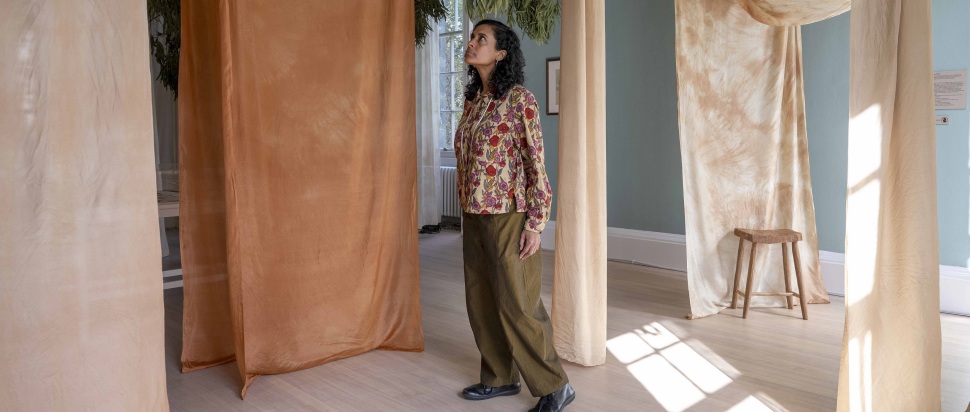Unearthing the Past: The colonialism behind botany
From eucalypts to cacti, our plants are rooted in colonialism. We look to Keg de Souza's exhibition Shipping Roots, the Glasgow Seed Library, and Indigenous knowledge to unpack the complex history of our botanics and question where we may grow from here
When Walter Scott donned tartan trousers in 1822, the popularity of tartan exploded and wool mills had to import fleece from Australia. But this fleece harboured hidden hitchhikers: Australian seeds and spiky burrs had latched on and soon grew as unstoppable weeds around these wool mills and beyond.
This story makes up one part of Shipping Roots, an immersive exhibition at the Royal Botanic Garden Edinburgh’s Inverleith House. Artist Keg de Souza explores how the British transported plants across their empire and the devastating consequences to nature and lives. Such colonialism continues to harm communities worldwide; and it’s crucial that we centre anti-colonialist practices when planting here in Scotland.
“Shipping Roots looks at the responsibility of the Botanic Garden, the history of colonialism and the movement of not only plants but also people through the hands of the British,” de Souza says. “It looks at the role of plants in building empires – the reason they collected these plants was to see what economic benefit they could potentially have.”
Shipping Roots examines three plant journeys, in three separate rooms. As a person of Indian (Goan) heritage living on unceded Gadigal land known as Sydney, de Souza predominantly links Australia, India and the UK in her work. The exhibition comes after the Royal Botanic Garden Edinburgh last year released its racial justice report, acknowledging its racist and colonial history.
The first room is filled with the scent of eucalyptus. Gum tree branches drape from the ceiling alongside orange-beige silks dyed with various eucalypt species. The voices of scientists and 100-year-old Bigambul elder Uncle Wes Marne play over speakers.
Eucalypts have been exported worldwide for their timber, particularly into India. But the timber’s economic value is heavily offset by the tree’s capacity for environmental destruction, causing water levels to plunge and wildfire risk to skyrocket. “Without Traditional Knowledge and the ecology of the country, a whole system to support these trees, we can see the damage they do in other places,” de Souza says.
Another room looks at the tide of prickly pear cacti the British introduced to Australia in a failed attempt to start a dye industry. By the 1920s, the cactus rendered millions of hectares of agricultural land unusable.
A third room explores fleece imports. While some trapped seeds and burrs didn’t survive in Scottish conditions, others now occupy vast areas, such as piri piri burrs on sand dunes near nature reserves. “I found it interesting that they were importing from a country they had taken sheep to as part of settling the colony,” says de Souza.
Indeed, plants have spread across the planet for millennia. European colonisation, however, significantly sped up this process. For colonisers like the British, introducing plants and exploiting land was in pursuit of wealth rather than for the good of the community, as De Souza’s exhibition makes clear. Putting colonial profit before people has not only destroyed native ecosystems and changed the climate; it has also disconnected people from plants.
Monash University academic and Euahlayi man Bhiamie Williamson explains that the movement of plants has changed and challenged Indigenous peoples’ relationships with their lands and waters. “Historically, before European people came into many of our lands, they were preceded by animals (foxes, rabbits, sheep) and weeds. So in many ways, Indigenous peoples have always engaged with weeds and introduced plants as a kind of harbinger of change to come,” he says.
“But change by itself doesn't always equate to disruption as change is always part of adaptive processes and cycles. I guess the more pertinent question is whether these new plants (or weeds) can be of use or are a destructive force in their new contexts.”
Indeed, exciting initiatives in Scotland, such as Glasgow Seed Library, show how we can sow anti-colonial practices. The Seed Library maintains a collection of seeds for people to borrow from, and hosts events and workshops on saving seeds and growing from seeds, often in small spaces. It aims to build climate and community resilience by nurturing varieties suitable for the changing Scottish climate and reconnecting folks to their food.
Seed Librarian Rowan Lear explains that the initiative aims to be anti-colonial; as such, it recognises we owe much of our food knowledge and diversity to Indigenous people in other countries. "Seed saving and sharing didn't just happen elsewhere, it was the regular practice of ordinary people in Scotland: growers, crofters and healers,” says Rowan. “And like Indigenous cultures elsewhere, I suspect the care of seeds was work done by women.
“It’s knowledge we’ve deliberately been separated from. We’ve not only lost access to land, but we‘ve also lost access to our knowledge about herbs, wild foods and also cultivating foods.” By learning to grow from seed, even from a balcony or window sill, Scottish people can reclaim such knowledge.
In Australia, practising decolonisation also means returning land to Indigenous people. “Without ownership and possession of the land we will always be curtailed in managing it in the ways we want to,” Bhiamie Williamson says. “So how to do better? Give us our land back and we will manage it the way we have always known how.” Shipping Roots makes this abundantly clear, and reminds us there is much to learn from their expertise.
Shipping Roots is at Royal Botanic Garden Edinburgh until 27 Aug. For more information on Glasgow Seed Library, see @glasgowseedlib on Instagram.
